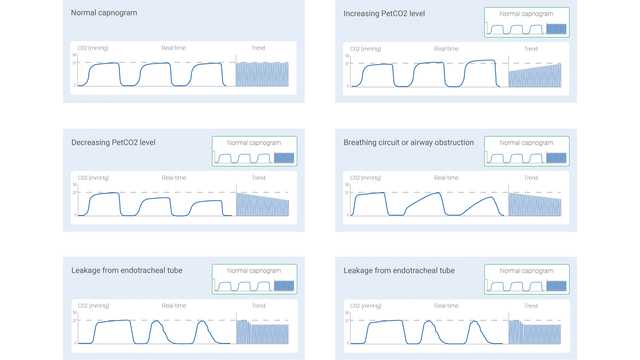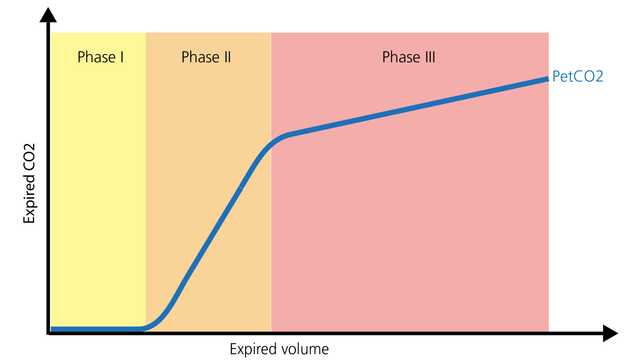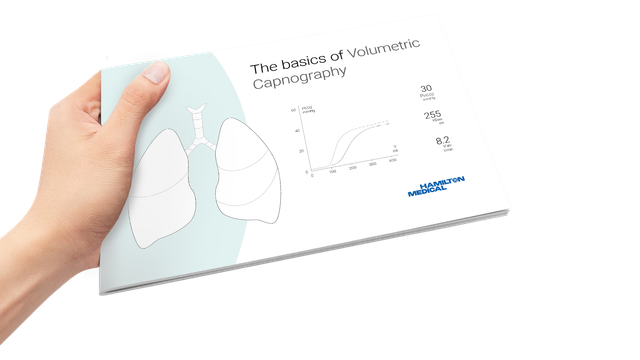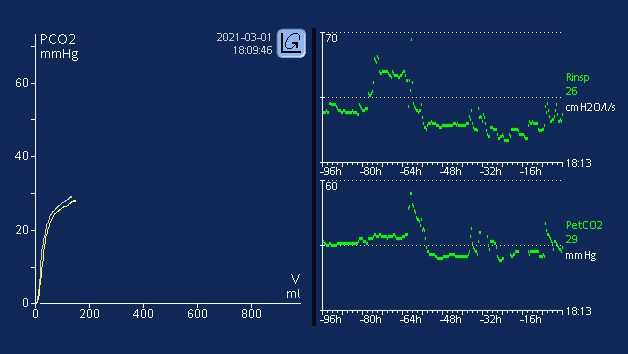
作者: Joe Hylton,MA,BSRT,RRT-ACCS/NPS,NRP,FAARC,FCCM,临床应用专家,Hamilton Medical Inc.
日期: 15.07.2021
波形二氧化碳图对重症监护医学并不陌生。它是一种广泛使用的气道管理验证工具,广泛用于清醒镇静环境,以及需要机械通气的插管病人的机构间转运。 波形二氧化碳图可以为训练有素的护理人员提供及时、有价值的信息。

有许多因素可能会影响潮气末二氧化碳分压 (PetCO2)。为消除二氧化碳,组织中二氧化碳的产生、血液中二氧化碳的运输、肺泡中的扩散和通过通气消除之间存在着密切、持续的平衡 (
病人的代谢率升高或降低将导致二氧化碳产生率的变化,因此也会影响 CO2 清除状态。如果循环和通气都是稳定的——这种状态只能在被动机械通气的病人中实现——二氧化碳监测可以用作二氧化碳产生的指标。发烧、败血症、疼痛和癫痫发作都会增加代谢,导致二氧化碳产生相应增加,进而使 PetCO2 增加。代谢下降发生在体温过低、镇静和瘫痪的病人中。这降低了二氧化碳的产生,如果分钟通气量不同时增加,可能会导致 PetCO2 降低 (
二氧化碳向肺部的运输依赖于适当的心血管功能;因此,任何改变心血管功能的因素都可能影响二氧化碳向肺部的运输 (
从肺部到环境的二氧化碳消除受呼吸功能变化的影响。因此,导致呼吸功能受损的阻塞性肺病、肺炎、神经肌肉疾病和中枢神经系统疾病将影响 PetCO2 值的变化 (
测量的 CO2 信号可以作为时间函数(基于时间的二氧化碳图)或呼气容量函数(容积二氧化碳图)来记录。这两种不同类型的二氧化碳图可能提供的信息量差异很大。文献中描述了基于时间的二氧化碳图中的某些形式,它们是特定临床情况下的典型形式。下面图 1 显示了一些常见形式。
然而,基于时间的二氧化碳图也有局限性:它无法提供对肺部通气-灌注状态的准确估计,也不能用来估计生理死区的组成部分。虽然容积二氧化碳图不如基于时间的二氧化碳图简单方便,但它具有提供更多信息的优势。

容积二氧化碳图的正常形状包括三个阶段。务必要记住,二氧化碳图代表呼气。

二氧化碳图(无论是基于时间的还是容量)可以提供有价值的信息,以优化对需要院内/院间转运的病人的监测和指导护理。只要提供有效的密封,它可以安全地用于气管内插管、气管切开插管和许多声门上气道。气道放置和通畅性、通气监测和灌注状态都是 PetCO2 提供重要信息的方面。另一个有价值的参数是每分钟二氧化碳清除量 (V'CO2),它使护理人员能够评估有效的灌注和容量复苏努力 (
在重症监护室,波形二氧化碳图可以通过各种气道辅助设备继续监测气道放置和通畅性。死区与潮气量比率 (VD/Vt) 是一个重要的二氧化碳图测量指标。 VD/Vt 比率升高可基于升高水平表示死亡率的潜在增加 (
所有 Hamilton Medical 哈美顿医疗公司呼吸机(

学习如何解读容积二氧化碳图及了解容积二氧化碳图的优点和临床应用。包括自测内容!

Learn everything you need to know in our guide to volumetric capnography: the volumetric capnogram, the capnography phases, what is dead space, the difference between anatomical dead space and alveolar dead space, PetCO during bronchospasm, V‘CO and CO2 elimination, and more.

It is well established that metabolism, perfusion, and efficient lung function are paramount to effective CO2 transport and elimination (1). Changes in a patient’s metabolic state, perfusion, or lung function can affect CO2 elimination, sometimes drastically.